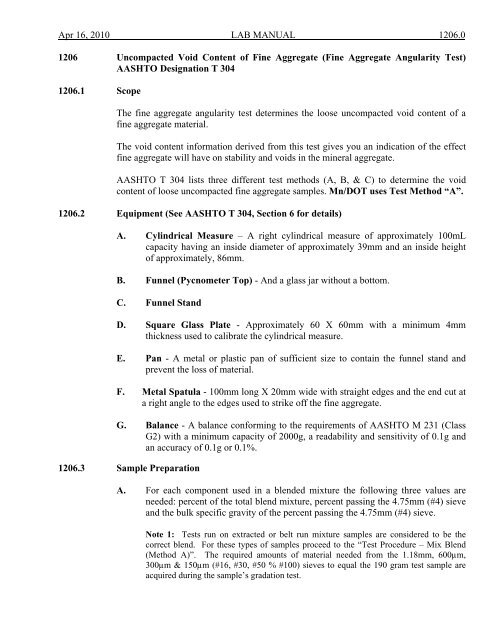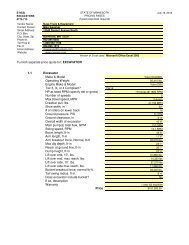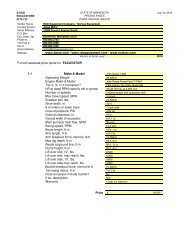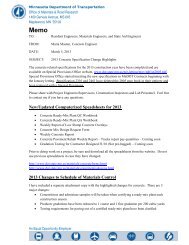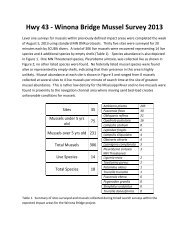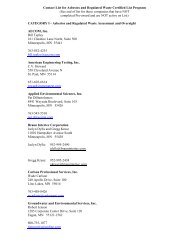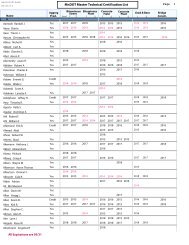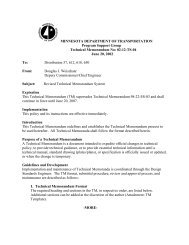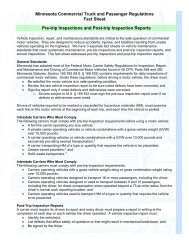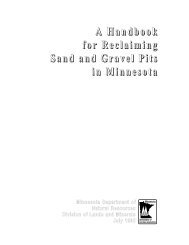1206 Uncompacted Void Content of Fine Aggregate
1206 Uncompacted Void Content of Fine Aggregate
1206 Uncompacted Void Content of Fine Aggregate
You also want an ePaper? Increase the reach of your titles
YUMPU automatically turns print PDFs into web optimized ePapers that Google loves.
Apr 16, 2010 LAB MANUAL <strong>1206</strong>.0<br />
<strong>1206</strong> <strong>Uncompacted</strong> <strong>Void</strong> <strong>Content</strong> <strong>of</strong> <strong>Fine</strong> <strong>Aggregate</strong> (<strong>Fine</strong> <strong>Aggregate</strong> Angularity Test)<br />
AASHTO Designation T 304<br />
<strong>1206</strong>.1 Scope<br />
The fine aggregate angularity test determines the loose uncompacted void content <strong>of</strong> a<br />
fine aggregate material.<br />
The void content information derived from this test gives you an indication <strong>of</strong> the effect<br />
fine aggregate will have on stability and voids in the mineral aggregate.<br />
AASHTO T 304 lists three different test methods (A, B, & C) to determine the void<br />
content <strong>of</strong> loose uncompacted fine aggregate samples. Mn/DOT uses Test Method “A”.<br />
<strong>1206</strong>.2 Equipment (See AASHTO T 304, Section 6 for details)<br />
A. Cylindrical Measure – A right cylindrical measure <strong>of</strong> approximately 100mL<br />
capacity having an inside diameter <strong>of</strong> approximately 39mm and an inside height<br />
<strong>of</strong> approximately, 86mm.<br />
B. Funnel (Pycnometer Top) - And a glass jar without a bottom.<br />
C. Funnel Stand<br />
D. Square Glass Plate - Approximately 60 X 60mm with a minimum 4mm<br />
thickness used to calibrate the cylindrical measure.<br />
E. Pan - A metal or plastic pan <strong>of</strong> sufficient size to contain the funnel stand and<br />
prevent the loss <strong>of</strong> material.<br />
F. Metal Spatula - 100mm long X 20mm wide with straight edges and the end cut at<br />
a right angle to the edges used to strike <strong>of</strong>f the fine aggregate.<br />
G. Balance - A balance conforming to the requirements <strong>of</strong> AASHTO M 231 (Class<br />
G2) with a minimum capacity <strong>of</strong> 2000g, a readability and sensitivity <strong>of</strong> 0.1g and<br />
an accuracy <strong>of</strong> 0.1g or 0.1%.<br />
<strong>1206</strong>.3 Sample Preparation<br />
A. For each component used in a blended mixture the following three values are<br />
needed: percent <strong>of</strong> the total blend mixture, percent passing the 4.75mm (#4) sieve<br />
and the bulk specific gravity <strong>of</strong> the percent passing the 4.75mm (#4) sieve.<br />
Note 1: Tests run on extracted or belt run mixture samples are considered to be the<br />
correct blend. For these types <strong>of</strong> samples proceed to the “Test Procedure – Mix Blend<br />
(Method A)”. The required amounts <strong>of</strong> material needed from the 1.18mm, 600µm,<br />
300µm & 150µm (#16, #30, #50 % #100) sieves to equal the 190 gram test sample are<br />
acquired during the sample’s gradation test.
Apr 16, 2010 LAB MANUAL <strong>1206</strong>.3A1<br />
1. Example <strong>of</strong> a four component mixture<br />
% <strong>of</strong><br />
Mixture<br />
% Passing<br />
4.75mm (#4)<br />
Sp. Gr.<br />
-4.75mm (#4)<br />
<strong>Aggregate</strong> #1 81 71 2.648<br />
<strong>Aggregate</strong> #2 9 98 2.637<br />
<strong>Aggregate</strong> #3 5 25 2.691<br />
<strong>Aggregate</strong> #4 5 94 2.545<br />
B. Calculate the - 4.75mm (#4) percentage to be used from each component<br />
1. (% <strong>of</strong> mixture) x (% passing 4.75mm [#4] sieve) ÷ 100<br />
<strong>Aggregate</strong> #1: 81 x 71 ÷ 100 = 57.51%<br />
<strong>Aggregate</strong> #2: 9 x 98 ÷ 100 = 8.82%<br />
<strong>Aggregate</strong> #3: 5 x 25 ÷ 100 = 1.25%<br />
<strong>Aggregate</strong> #4: 5 x 94 ÷ 100 = 4.70%<br />
C. Calculate the Total Blend passing the #4.75mm (#4) sieve by adding the values<br />
from <strong>1206</strong>.3B1.<br />
1. 57.51 + 8.82 + 1.25 + 4.7 = 72.28%<br />
D. Determine the amount <strong>of</strong> material, in grams, needed from each aggregate<br />
component so a sufficient representative sample <strong>of</strong> the total mixture blend is<br />
retained, after sieving, on each sieve size 1.18mm, 600µm, 300µm & 150µm (#16,<br />
#30, #50 % #100) sieves (Example shown is for 600 grams.)<br />
1. 600 x % passing 4.75mm (#4) sieve for each component<br />
Total % passing 4.75mm (#4) in the blend<br />
<strong>Aggregate</strong> #1: (600 x 57.51) ÷ 72.28 = 477.4g<br />
<strong>Aggregate</strong> #2: (600 x 8.82) ÷ 72.28 = 73.2g<br />
<strong>Aggregate</strong> #3: (600 x 1.25) ÷ 72.28 = 10.4g<br />
<strong>Aggregate</strong> #4: (600 x 4.70) ÷ 72.28 = 39.0g<br />
E. Calculate the mix blend - #4 (4.75mm) specific gravity to be used in the <strong>Fine</strong><br />
<strong>Aggregate</strong> Angularity calculation.<br />
1. Total the values <strong>of</strong> the four aggregates in Section <strong>1206</strong>.3B1.<br />
(57.51 + 8.82 + 1.25 + 4.70 = 72.28
Apr 16, 2010 LAB MANUAL <strong>1206</strong>.3E2<br />
2. For each <strong>of</strong> the four aggregates divide the values in Section <strong>1206</strong>.3B1 by the<br />
specific gravity <strong>of</strong> the appropriate aggregate and total those values.<br />
<strong>Aggregate</strong> #1: 57.51 ÷ 2.648 = 21.72<br />
<strong>Aggregate</strong> #2: 8.82 ÷ 2.637 = 3.34<br />
<strong>Aggregate</strong> #3: 1.25 ÷ 2.691 = 0.46<br />
<strong>Aggregate</strong> #4: 4.70 ÷ 2.545 = 1.85<br />
27.37<br />
3. Divide the total achieved in <strong>1206</strong>.3E1 by the total achieved in <strong>1206</strong>.3E2 to arrive<br />
at the Mix Blend –4.75mm (#4) specific gravity which will be used in the<br />
calculation <strong>of</strong> the <strong>Fine</strong> <strong>Aggregate</strong> Angularity.<br />
72.28<br />
27.37<br />
= 2.641 (Mix Blend Specific Gravity)<br />
<strong>1206</strong>.4 Calibration <strong>of</strong> Cylindrical Measure<br />
A. First determine the volume <strong>of</strong> your cylindrical measure by using the following<br />
calibration procedure.<br />
1. Apply a thin coat <strong>of</strong> grease to the top edge <strong>of</strong> your dry, empty cylinder<br />
measure.<br />
2. Determine the mass <strong>of</strong> measure, grease and glass plate by weighing.<br />
3. Fill your measure with freshly boiled, deionized water adjusted to a temperature<br />
<strong>of</strong> 18 - 24 °C (60 - 75 °F).<br />
4. Determine and record the temperature <strong>of</strong> the water.<br />
5. Slide the glass plate onto the top <strong>of</strong> your measure in a manner ensuring that no air<br />
bubbles will be trapped under the glass plate.<br />
6. Dry the outside surfaces <strong>of</strong> your measure and determine the mass <strong>of</strong> the measure,<br />
water, glass plate and grease by weighing.<br />
7. After the final weighing, remove the grease and determine the mass <strong>of</strong> your clean,<br />
dry, empty measure for subsequent tests.
Apr 16, 2010 LAB MANUAL <strong>1206</strong>.4A8<br />
8. Determine the volume (to the nearest 0.1-ml <strong>of</strong> the measure where:<br />
M = Net mass (weight) <strong>of</strong> water in grams.<br />
D = Density <strong>of</strong> the water. kg/m³<br />
Note 2: See the table in AASHTO T 19/T 19M-93, Section 8.4 for the water density based<br />
on the temperature <strong>of</strong> the water used. It will be necessary to interpolate between the values<br />
shown in that table. In the example a water temperature <strong>of</strong> 22.28 °C. is used, values<br />
marked with an asterisk (*) are from the referenced table (above) and the density in kg/m 3<br />
calculated as follows:<br />
[(997.97* – 997.54*) ÷ (23.0* – 21.1*)] = 0.2263<br />
D = {997.54 + [0.2263 x (23.0 – 22.28)]} = 997.7029 = 997.70<br />
Weight <strong>of</strong> Measure, grease, and glass plate = 226.1 g<br />
Weight <strong>of</strong> Measure, grease, glass plate, and water = 325.7 g<br />
M = (325.7 g – 226.1 g) = 99.6 g<br />
Volume <strong>of</strong> measure (cylinder), mL is determined as follows:<br />
V = 1000 x (M ÷ D)<br />
V = {1000 x 99.6 ÷ 997.70 = 99.83 mL<br />
<strong>1206</strong>.5 Test Procedure – Mix Blend (Method A)<br />
A. Weigh out and combine the following quantities <strong>of</strong> your fine aggregate blend that<br />
has been dried and sieved in accordance with AASHTO T 27 as follows:<br />
Passing 2.36mm (#8) sieve and retained on the 1.18mm (#16)<br />
Passing 1.16mm (#16) sieve and retained on the 600µm (#30)<br />
Passing 600μm (#30) sieve and retained on the 300µm (#50)<br />
Passing 300μm (#50) sieve and retained on the 150µm (#100)<br />
Total<br />
= 44 grams<br />
= 57 grams<br />
= 72 grams<br />
= 17 grams<br />
= 190 grams<br />
Note 3: The tolerance for each <strong>of</strong> these increments is ± 0.2 grams.<br />
B. Thoroughly mix the individual sieve increments with a spatula until it appears to<br />
be a homogeneous 190-gram sample.<br />
C. Position the jar and funnel section in the stand and center the cylindrical measure.<br />
D. Using a finger, block the opening <strong>of</strong> the funnel.<br />
E. Pour the test sample into the funnel and level with a spatula.
Apr 16, 2010 LAB MANUAL <strong>1206</strong>.5F<br />
F. Remove your finger and allow the material to fall freely in the cylindrical<br />
measure.<br />
G. After the funnel empties and the cylindrical measure is full, strike-<strong>of</strong>f the excess<br />
fine aggregate with a single pass <strong>of</strong> the spatula using the straight edge <strong>of</strong> the blade<br />
vertically and in light contact with the top <strong>of</strong> the measure.<br />
Note 4: Until this operation is completed avoid any vibration or disturbance that could<br />
cause the material to compact.<br />
H. After strike-<strong>of</strong>f, lightly tap the cylinder to compact the material so none will be<br />
lost when transferring the cylinder to the scale and brush the adhering material<br />
from the outside <strong>of</strong> the cylinder.<br />
I. Determine the mass <strong>of</strong> the cylinder and material to the nearest 0.1g and record.<br />
J. Do Sections <strong>1206</strong>.5B through <strong>1206</strong>.5H twice and determine the average <strong>of</strong> the<br />
two readings minus the weight <strong>of</strong> the cylinder.<br />
K. Calculate the <strong>Uncompacted</strong> <strong>Void</strong>s as follows:<br />
U = V – (F/G) x 100<br />
V<br />
Where:<br />
U = <strong>Uncompacted</strong> <strong>Void</strong>s<br />
V = Volume <strong>of</strong> Measure<br />
F = Net mass <strong>of</strong> fine aggregate in the measure<br />
(Average mass determined in step #10 above)<br />
G = Bulk Dry Specific Gravity <strong>of</strong> the Blend <strong>of</strong> fine aggregate<br />
L. Report the <strong>Uncompacted</strong> <strong>Void</strong>s to the 0.1 percent.
Apr 16, 2010 LAB MANUAL <strong>1206</strong>.6<br />
<strong>1206</strong>.6 Report Form<br />
FINE AGGREGATE ANGULARITY<br />
(UNCOMPACTED VOIDS IN FINE AGGREGATE)<br />
(AASHTO T 304)<br />
Laboratory No. ______________________ Bituminous Rec. ID __________________<br />
Source _________________________________________________________________<br />
Location _______________________________________________________________<br />
Tested By ______________________________________ Date ____________________<br />
Lab ID# ____________<br />
(G) Avg. Specific Gravity ____________<br />
(V) Volume <strong>of</strong> cylinder ____________<br />
(A) Tare weight <strong>of</strong> cylinder ____________<br />
Test Runs<br />
Weight <strong>of</strong> cylinder Run 1 _________<br />
And aggregate Run 2 _________<br />
(Run 1 + Run 2) Total _________<br />
(B) (Total ÷ 2) Average _________<br />
Note that the two formulas below for <strong>Uncompacted</strong> <strong>Void</strong>s give the same result.<br />
<strong>Uncompacted</strong> voids = {[V - ((B - A) ÷ G)] ÷ V} × 100 or<br />
<strong>Uncompacted</strong> voids = V -<br />
V<br />
B - A<br />
G<br />
× 100<br />
<strong>Uncompacted</strong> voids (0.1%) = __________.___%<br />
Remarks:


